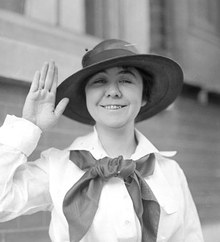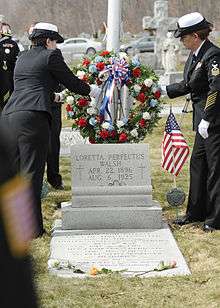Loretta Perfectus Walsh
Loretta Perfectus Walsh (April 22, 1896 – August 6, 1925) became the first American active-duty Navy woman, the first woman to enlist in the U.S. Navy, and the first woman allowed to serve as a woman in any of the United States armed forces, as anything other than as a nurse, when she enlisted in the U.S. Naval Reserve on March 17, 1917. Walsh subsequently became the first woman U.S. Navy petty officer when she was sworn in as Chief Yeoman on March 21, 1917.
Loretta Perfectus Walsh | |
|---|---|
 | |
| Born | April 22nd, 1896 Philadelphia, Pennsylvania, United States |
| Died | August 6th, 1925 Olyphant, Pennsylvania, United States |
| Employer | United States Navy |
Biography
Early life
Loretta Walsh born in 1896 in Philadelphia, Pennsylvania.
Career
War events quickly led up to Walsh's decision to enlist in the United States Navy. World War I was in its fourth year when, on January 31, 1917 the Germans announced they would resume unrestricted submarine warfare on all ships, including those sailing under the United States flag. On February 23, 1917, American opinion further was angered when America learned of Berlin's proposal to Mexico to join the war as Germany's ally against the U.S.[1] Over the next few weeks, four American ships fell victim to German U-boats, causing the death of fifteen Americans.
On March 12, 1917, all American merchant ships were ordered to be armed in war zones.[2] On March 13, 1917, these armed merchant ships were authorized to take action against German U-boats.[2]"Dates in American Naval History: March". Naval History & Heritage Command. Archived from the original on October 7, 2012.</ref> It was in the face of this adversity challenging the United States that Walsh made her decision to enlist in the United States military.
At age 20, on March 17, 1917, Walsh engaged in a four-year enlistment in the U.S. Navy, becoming the first active-duty Navy woman, the first woman to enlist in the Navy, and the first woman to serve in any of the armed forces in a non-nurse occupation.[3][4] On March 19, 1917, the Navy Department authorized enrollment of women in Naval Reserve with ratings of yeoman, radio electrician, or other essential ratings, becoming the first branch of the United States armed forces to allow enlistment by women in a non-nursing capacity.[2] Walsh subsequently became the first woman Navy petty officer when she was sworn in as Chief Yeoman on March 21, 1917.[2][5]
12 days after Walsh was sworn in as Chief Yeoman, President Woodrow Wilson went before the U.S. Congress late on April 2 to ask for a declaration of war, which Congress did on April 6, 1917.[6]
The war ended on November 11, 1918. Walsh and other female yeomen, all of whom held enlisted ranks, continued in service during the first months after the November 1918 Armistice was signed.[7] However, as a result of the post-World War I Naval reductions, the number of Yeomen (F) declined steadily, reaching just under four thousand by the end of July 1919, when Walsh and the remaining Yeomen (F) were all released from active duty.[8][7] Walsh continued on inactive reserve status, receiving modest retainer pay, until the end of her four-year enlistment on March 17, 1921.[7]
Walsh's contribution
In 1917, women had served in the United States military as nurses since 1901. However, despite their uniforms, Army and Navy nurses were civilian employees with few benefits. For example, women lacked "relative ranks" and insignia, retirement pension, disability pension if injured in the line of duty. On enlisting in the Navy in early 1917, Walsh became a Yeoman (F), commonly called Yeomanettes. Yeomanettes primarily served in clerical positions. As a non-nurse, Walsh was the first of 13,000 World War I yeoman females entitled to receive the same benefits and responsibilities as men, including identical pay.[3]
Legacy

Walsh fell victim to influenza in the fall of 1918, later contracting tuberculosis.[9] She died on August 6, 1925 at the age of 29 in Olyphant, Pennsylvania.[8] After her death she was buried in Olyphant's St. Patrick's Cemetery, under a monument that reads:[8]
Loretta Perfectus Walsh
April 22, 1896–August 6, 1925
Woman and Patriot
First of those enrolled in the United States Naval Service
World War 1917–1919
Her comrades dedicate this monument
to keep alive forever
memories of the sacrifice and devotion of womanhood
In memory of Walsh and her bold actions on March 21, 1917, the official history program of the Department of the Navy, the Naval Historical Center, identifies March 21, 1917 as a date in American naval history.[2]
There have been some efforts to document Walsh's story. For example, in 1982, former U.S. Navy lieutenant, Jean Ebbert and Mary-Beth Hall set out to document the story of Walsh as the first Navy woman to serve outside the nursing profession.[10] The resulting book, Crossed Currents: Navy Women from WWI to Tailhook,[11] was published in December 1994. It was followed by a second book devoted to Navy and Marine Corps women in World War I, The first, the few, the forgotten: Navy and Marine Corps Women in World War I, containing additional information about Walsh.[9]
See also
- History of the United States Navy
- History of women in the military
- Women in the United States Navy
- Yeoman (F)
References
- Zimmermann Telegram. Obtained November 10, 2006.
- Naval Historical Center. (September 23, 2005). Dates in Naval History: March.(Dead Link as of 27/09/2017) Obtained November 10, 2006.
- Beyond The InterNet (August 2004). The Navy Then and Now. Obtained November 10, 2006.
- Jennifer Pompi (July 1, 2014). "Michelle J. Howard becomes Navy's first female 4-star admiral". The Washington Times. Retrieved October 3, 2019.
- the Goat Locker. Chief Petty Officer Indoctrination. Obtained November 10, 2006.
- See, Woodrow Wilson declares war on Germany on Wikisource. Obtained November 10, 2006
- Naval Historical Center. (May 6, 2000). Women & the U.S. Navy -- World War I era Yeomen (F). Archived 2008-03-24 at the Wayback Machine Obtained November 10, 2006.
- Pointon, Terri. Rootsweb.com. St. Patrick's Cemetery, Olyphant. Obtained November 10, 2006.
- Ebbert, Jean; Hall, Mary-Beth (2002). The first, the few, the forgotten: Navy and Marine Corps Women in World War I. Naval Institute Press; ISBN 1-55750-203-X
- Kidder, Chris. (December 13, 1993). Virginia Pilot and Ledger-Star. The Evolution of Women in the Navy: Shifting Policy is easier than Changing Attitudes, "Crossed Currents" Finds, p. 9
- Ebbert, Jean; Hall, Mary-Beth (1994). Crossed Currents: Navy Women from WWI to Tailhook. Brassey's Inc, Revised edition. ISBN 0-02-881112-7
Further reading
- Ebbert, Jean and Marie-Beth Hall (2002). The First, the Few, the Forgotten: Navy and Marine Corps Women in World War I. Annapolis, MD: The Naval Institute Press. ISBN 1-55750-203-X.
- Godson, Susan H. (2001). Serving Proudly: A history of Women in the U.S. Navy. Annapolis, MD: Naval Institute Press. ISBN 1-55750-317-6.
- Ebbert, Jean and Marie-Beth Hall (1999). Crossed Currents: Navy Women from WWI to Tailhook [Revised]. Washington, D.C.: Brassey's. ISBN 978-1-57488-193-6.